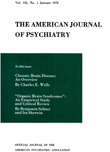ORGANIC INTEGRITY TEST CONFIRMED
Abstract
1. The Organic Integrity Test (OIT) designed by Tien in 1959, giving validity to the theory of chromaphilia, is now confirmed by Astrom, Engelsmann and Drdkova.
2. The OIT is confirmed independently in Sweden by Astrom, at Linkoping. He showed convincingly that the data obtained from a non-organic, non-psychotic group, and a suspected organic group and a purely organic group, revealed a highly significant difference between them. He further demonstrated that there is no significant difference between the suspected organic group and the definite organic group. He also showed that the OIT gives a good correlation with other more lengthy tests measuring the degree of brain damage, with retesting reliability of (0.775).
3. The test is further confirmed by Engelsmann and Drdkova at Prague Psychiatric Research Institute, Czechoslovakia. Engelsmann and Drdkova confirmed that the OIT showed a high level of significance in differentiating between normals and organics, normals and psychotics, but not between normals and neurotics.
4. A much larger confirmatory study (N = 342, X = 78, S = 15) was made at the Oldsmobile Plant, taking into consideration both age (R = –0.106) and intelligence (R = –0.04). The results showed again a high level of significance in standardizing the normal intact brain functioning by the OIT. And when combined with the previous studies, we showed that a non-organic, nonpsychotic adult with borderline or better intelligence (IQ > 79) scores on the average an OIT of 78 ± 15 (morphophilism), whereas any adult suffering either organic brain syndrome, psychosis, or definite mental deficiency scores on the average an OIT value of only 34 ± 23 (chromaphilia).
5. With the confirmation of the OIT, Tien's theory of chromaphilia has thus succeeded in isolating an important objective psychodiagnostic variable of Rorschach, namely, the color-naming response, which significance has heretofore been elusive. Chromaphilia is now clearly shown on the OIT as a CNS deficit, a lower level of neurophysiological integration due to decreased form perception (morphophilism).
6. The OIT is also confirmed as a highly efficient test (which can be given and scored in 3 to 4 minutes), and may be employed as a mass screening test in psychiatric clinics, in psychological laboratories, in industry, in schools, in armed forces, in hospitals and in everyday psychiatric or neurological practice, and as a routine neuropsychiatric test in the offices of general practitioners.
Access content
To read the fulltext, please use one of the options below to sign in or purchase access.- Personal login
- Institutional Login
- Sign in via OpenAthens
- Register for access
-
Please login/register if you wish to pair your device and check access availability.
Not a subscriber?
PsychiatryOnline subscription options offer access to the DSM-5 library, books, journals, CME, and patient resources. This all-in-one virtual library provides psychiatrists and mental health professionals with key resources for diagnosis, treatment, research, and professional development.
Need more help? PsychiatryOnline Customer Service may be reached by emailing [email protected] or by calling 800-368-5777 (in the U.S.) or 703-907-7322 (outside the U.S.).



